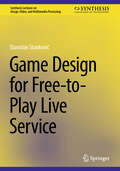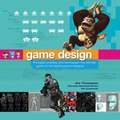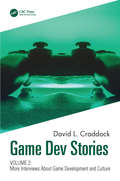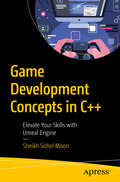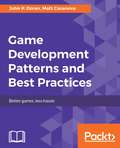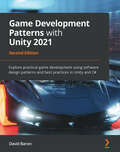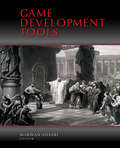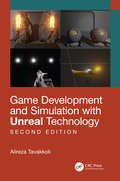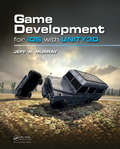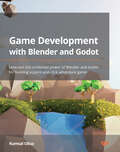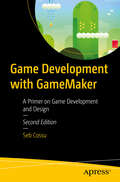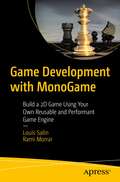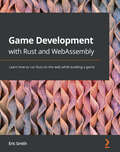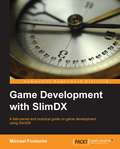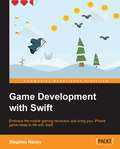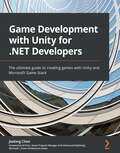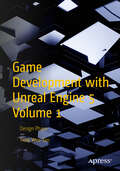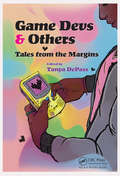- Table View
- List View
Game Design for Free-to-Play Live Service (Synthesis Lectures on Image, Video, and Multimedia Processing)
by Stanislav Stanković"Game Design for Free to Play Live Service" is the ultimate guide to designing successful free-to-play mobile games. Based on a decade of experience at companies like Rovio, EA, and Supercell, the author provides practical advice on gameplay mechanics, monetization strategies, and player engagement. With case studies and expert insights, this book is essential reading for any game developer looking to create a hit mobile game.
Game Design: From Blue Sky to Green Light
by Deborah ToddThis book takes a real-world, in-depth journey through the game-design process, from the initial blue sky sessions to pitching for a green light. The author discusses the decision and brainstorming phase, character development and story wrap, creation of content and context outlines, flowcharting game play, and creating design documents. Special fe
Game Design: Principles, Practice, and Techniques - The Ultimate Guide for the Aspiring Game Designer
by Jim Thompson Barnaby Berbank-Green Nic CusworthPractical, complete coverage of game design basics from design process to production This full-color, structured coursebook offers complete coverage of game design basics, focusing on design rather than computer programming. Packed with exercises, assignments, and step-by-step instructions, it starts with an overview of design theory, then progresses to design processes, and concludes with coverage of design production. Jim Thompson, Barnaby Berbank-Green, and Nic Cusworth (London, UK) are computer game designers and lecturers in animation and computer game design.
Game Dev Stories Volume 2: More Interviews About Game Development and Culture
by David L. CraddockGame Dev Stories: Interviews About Game Development and Culture Volumes 1 and 2 are a collection of interviews from renowned author David L. Craddock as he explores all corners of the video game industry. Collected from the author's archives, Game Dev Stories gathers conversations with individuals from all corners of the industry: Who they are, the paths they paved, and their contributions to this multibillion-dollar industry. This text offers viewpoints from well-known individuals like John Romero, Tom Hall, and Matt Householder. From artists and writers to programmers and designers, Game Dev Stories offers amazing insights and understanding to what occurs behind the screens of your favorite games and may help inspire future game developers in pursuing their dreams. Author Bio David L. Craddock writes fiction, nonfiction, and grocery lists. He is the author of over a dozen nonfiction books about video game development and culture, including the bestselling Stay Awhile and Listen series, Arcade Perfect: How Pac-Man, Mortal Kombat, and Other Coin-Op Classics Invaded the Living Room, and fiction for young adults, including The Dumpster Club and Heritage: Book One of the Gairden Chronicles. Find him online @davidlcraddock on Twitter.
Game Development 2042: The Future of Game Design, Development, and Publishing
by Tim FieldsThis book is a fast-paced look at the next two decades of the games industry with a focus on game design, the evolution of gaming markets around the world, the future of technology, Artificial Intelligence, Big Data, crypto-currency, and the art and business of creating and publishing hit games. The book contains interviews with a dozen veteran games industry luminaries, who have collectively created many of the greatest hits of the last twenty years and grossed tens of billions of dollars in revenue for companies like Electronic Arts, Facebook, Apple, Activision, Microsoft, Amazon, Supercell, Netflix, Warner Brothers, and others. Game Development 2042 is meant for game developers, anyone with a financial interest in the games business, and for gamers who want to know what the future holds. Mobile, console, PC, web, free-to-play, play-to-earn, and other businesses are discussed in depth with specific examples.
Game Development Concepts in C++: Elevate Your Skills with Unreal Engine
by Sheikh Sohel MoonLeverage Unreal Engine to implement a wide variety of mechanics using C++. This book arms you with the knowledge and practices of game mechanics programming in C++, supported by detailed mathematical and programmatic explanations. Detailing everything from collision mechanics and AI pathfinding to networking and advanced physics, this book offers a holistic approach to game development, ensuring you get the most out of your gameplay experiences. You will work on character mechanics, environmental interactions, combat systems, and visual effects, gaining a thorough understanding of how to implement these features in C++. By the time you finish this book, you will be able to create complex game mechanics and to make your projects optimization-intensive and performance-driven. Whether you want to polish your skills or experiment with new techniques, Game Dev Concepts in C++ for Unreal Engine Practitioners gives you the right guidance and helps you to stand out in this competitive world of game development. What You Will Learn Understand detailed scenarios that demonstrate how each mechanic is applied in real-world game development projects. Utilize ready template codes for quicker implementation of mechanics in your games, saving time, and boosting productivity. Develop your skills in advanced Unreal Engine and C++ programming, making you a versatile and proficient game developer. <span lang="EN-IN" style="font-size: 12.0pt; font-family: 'Arial',sans-serif; mso-fareast
Game Development Patterns & Best Practices
by John P. DoranIf you are a game developer who wants to solve commonly-encountered issues or have some way to communicate to other developers in a standardized format, then this book is for you. Knowledge of basic game programming principles and C++ programming is assumed.
Game Development Patterns with Unity 2021: Explore practical game development using software design patterns and best practices in Unity and C#
by David BaronSolve your programming woes in Unity with practical design propositionsKey FeaturesGain a comprehensive overview of Unity engine architecture and coding modelBuild a complete racing game using software design patterns and understand how to implement them in UnityDownload the source code of the complete prototype demonstrating each of the software patterns usedBook DescriptionThis book is written for every game developer ready to tackle the bigger picture and start working with advanced programming techniques and design patterns in Unity. Game Development Patterns with Unity 2021 is an introduction to the core principles of reusable software patterns and how to employ them to build components efficiently. In this second edition, you'll tackle design patterns with the help of a practical example; a playable racing game prototype where you’ll get to apply all your newfound knowledge. Notable updates also include a game design document (GDD), a Unity programming primer, and the downloadable source code of a complete prototype. Your journey will start by learning about overall design of the core game mechanics and systems. You’ll discover tried-and-tested software patterns to code essential components of a game in a structured manner, and start using classic design patterns to utilize Unity's unique API features. As you progress, you'll also identify the negative impacts of bad architectural decisions and understand how to overcome them with simple but effective practices. By the end of this Unity book, the way you develop Unity games will change – you’ll adapt a more structured, scalable, and optimized process that will help you take the next step in your career. What you will learnStructure professional Unity code using industry-standard development patternsIdentify the right patterns for implementing specific game mechanics or featuresDevelop configurable core game mechanics and ingredients that can be modified without writing a single line of codeReview practical object-oriented programming (OOP) techniques and learn how they re used in the context of a Unity projectBuild unique game development systems such as a level editorExplore ways to adapt traditional design patterns for use with the Unity APIWho this book is forThis book is for Unity game developers who want to learn industry standards for building Unity games. Knowledge of the Unity game engine and programming in the C# language is a must, so if you’re a beginner, try our Learning C# by Developing Games with Unity 2021 handbook instead.
Game Development Patterns with Unity 2021: Explore practical game development using software design patterns and best practices in Unity and C#, 2nd Edition
by David BaronDiscover practical design propositions to resolve game programming challenges in UnityKey FeaturesGet an overview of Unity engine architecture and coding modelBuild a complete racing game using software design patterns and understand how to implement them in UnityDownload the source code of the complete prototype demonstrating each of the software patterns usedBook DescriptionUnity's coding model and architecture require knowledge of common software design patterns. To optimally code a game in Unity, in the same way you do in other engines, you'll have to adapt to programming techniques that involve the use of design patterns. In this second edition, you'll get to grips with using design patterns with the help of supplemented code examples based on actual implementations of game mechanics and systems of a playable racing game prototype. You'll be introduced to the core principles of reusable software patterns and how to employ them to build components efficiently. Some notable additions include a game design document (GDD), a Unity programming primer, and the downloadable source code of a complete prototype. You'll start by learning about the overall design of the core game mechanics and systems that you'll be building throughout this Unity book, and discover tried-and-tested software patterns to code essential components of a game in a structured manner. You'll also find out how you can use classic design patterns to utilize Unity's unique API features. Finally, you'll identify the negative impacts of bad architectural decisions and understand how to overcome them with simple but effective practices. By the end of this book, you'll be able to develop Unity games in a structured, scalable, and optimized way.What you will learnStructure professional Unity code using industry-standard development patternsIdentify the right patterns for implementing specific game mechanics or featuresDevelop configurable core game mechanics and ingredients that can be modified without writing a single line of codeReview practical object-oriented programming (OOP) techniques and learn how they're used in the context of a Unity projectBuild unique game development systems such as a level editorExplore ways to adapt traditional design patterns for use with the Unity APIWho this book is forThis book is for Unity game developers who want to learn industry standards for building Unity games. Knowledge of the Unity game engine and programming in the C# language is expected. If you're only just starting your journey to becoming a Unity game developer, this book is not suitable for you.
Game Development Projects with Unreal Engine: Learn to build your first games and bring your ideas to life using UE4 and C++
by Devin Sherry David Pereira Hammad Fozi Goncalo MarquesLearn the tools and techniques of game design using a project-based approach with Unreal Engine 4 and C++Key FeaturesKickstart your career or dive into a new hobby by exploring game design with UE4 and C++Learn the techniques needed to prototype and develop your own ideasReinforce your skills with project-based learning by building a series of games from scratchBook DescriptionGame development can be both a creatively fulfilling hobby and a full-time career path. It's also an exciting way to improve your C++ skills and apply them in engaging and challenging projects.Game Development Projects with Unreal Engine starts with the basic skills you'll need to get started as a game developer. The fundamentals of game design will be explained clearly and demonstrated practically with realistic exercises. You'll then apply what you've learned with challenging activities.The book starts with an introduction to the Unreal Editor and key concepts such as actors, blueprints, animations, inheritance, and player input. You'll then move on to the first of three projects: building a dodgeball game. In this project, you'll explore line traces, collisions, projectiles, user interface, and sound effects, combining these concepts to showcase your new skills.You'll then move on to the second project; a side-scroller game, where you'll implement concepts including animation blending, enemy AI, spawning objects, and collectibles. The final project is an FPS game, where you will cover the key concepts behind creating a multiplayer environment.By the end of this Unreal Engine 4 game development book, you'll have the confidence and knowledge to get started on your own creative UE4 projects and bring your ideas to life.What you will learnCreate a fully-functional third-person character and enemiesBuild navigation with keyboard, mouse, gamepad, and touch controlsProgram logic and game mechanics with collision and particle effectsExplore AI for games with Blackboards and Behavior TreesBuild character animations with Animation Blueprints and MontagesTest your game for mobile devices using mobile previewAdd polish to your game with visual and sound effectsMaster the fundamentals of game UI design using a heads-up displayWho this book is forThis book is suitable for anyone who wants to get started using UE4 for game development. It will also be useful for anyone who has used Unreal Engine before and wants to consolidate, improve and apply their skills. To grasp the concepts explained in this book better, you must have prior knowledge of the basics of C++ and understand variables, functions, classes, polymorphism, and pointers. For full compatibility with the IDE used in this book, a Windows system is recommended.
Game Development Tools
by Marwan AnsariThis book brings the insights of game professionals, DCC creators, hardware vendors, and current researchers together into a collection that focuses on the most underrepresented and critical part of game production: tools development. The first gems-type book dedicated to game tools, this volume focuses on practical, implementable tools for game de
Game Development and Simulation with Unreal Technology, Second Edition
by Alireza TavakkoliDr. Alireza Tavakkoli’s Game Development and Simulation with Unreal Technology covers the latest version of Unreal Technology. Since the 1990s Epic Games, Inc. has been leading the revolution of gaming graphics and Artificial Intelligence. Now, unreal technology is one of the most potent and prominent engines that is currently used in games. Its influence can be spotted in classic triple A titles like, Fortnite, Gears of War 2, Borderlands 2, and XCOM: Enemy Unknown. <P><P>Tavakkoli goes into detail concerning the creation of game level designs, blueprint coding, shader programing, as well as artificial intelligence concepts to help readers in creating their own games. Game Development also includes a number of practice friendly extensions and concept modules to help solidify the reader’s understanding of concepts and techniques. The book is divided into three sections that act as building blocks in order to facilitate the comprehension of the material. <P><P>Key Features: <P><P>Provides beginner level through advanced concepts in blueprint programming with the Unreal Engine 4.18 <P><P>Hundreds of small/mid-scale projects developed as concept examples throughout the book which can be utilized in more comprehensive entertaining interactive computer simulations and games <P><P>Chapter exercises will take the readers’ understanding of Unreal Engine to the next level.
Game Development for iOS with Unity3D
by Jeff W. MurrayThis hands-on guide takes you through the complete process of Unity iOS game development. A game developer for over 12 years, the author presents production-proven techniques and valuable tips and tricks needed to plan, build, test, and launch games for the iPhone, iPod, and iPad. He walks you through all the necessary procedures, including how to publish your game to the App Store.
Game Development with Blender and Godot: Leverage the combined power of Blender and Godot for building a point-and-click adventure game
by Kumsal ObuzUnderstand how to use one of the most popular 3D modeling software and advanced game engines to create a seamless workflow between the two and produce dynamic gamesKey FeaturesLearn how to create, rig, and animate 3D low-poly models in BlenderDiscover the 3D workflow of Godot Engine and understand how to enhance your modelsUse modeling and game design skills to create a dynamic point-and-click gameBook DescriptionGame Development with Blender and Godot is a comprehensive introduction for those new to building 3D models and games, allowing you to leverage the abilities of these two technologies to create dynamic, interactive, and engaging games.This book will start by focusing on what low-poly modeling is, before showing you how to use Blender to create, rig, and animate your models. You will also polish these assets until they're game-ready, making it easy for you to import them into Godot and use them effectively and efficiently. Next, you will use the game engine to design scenes, work with light and shadows, and transform your 3D models into interactive, controllable assets.By the end of this book, you will have a seamless workflow between Blender and Godot which is specifically geared toward game development. Alongside, you'll also be building a point-and-click adventure game following the instructions and guidance in the book. Finishing this game will help you take these newly acquired skills and create your own 3D games from conception to completion.What you will learnDiscover what low-poly modeling is and why it mattersUnderstand how to use materials, shaders, and textures in your modelsExplore how to render and animate a scene in BlenderFocus on how to export Blender assets and import them into GodotUse 3D low-poly models in Godot to create fun gamesDesign a dynamic and easy-to-navigate game worldExplore how to interact with the game via interfacesUnderstand how to export your game for WindowsWho this book is forThis book is for game developers who are looking to make the transition from 2D to 3D games. Readers should have a basic understanding of Godot, being able to navigate the UI, understand the inspector panel, create scenes, add scripts to game objects, and more. Previous experience with Blender is helpful but not required.
Game Development with Construct 2
by Lee Stemkoski Evan LeiderDesign and create video games using Construct 2. No prior experience is required. Game Development with Construct 2 teaches you to create 12 different game projects from a variety of genres, including car racing and tower defense to platformer and action-adventure. The software is user friendly and powerful, and the games you create can be exported to run on the web, desktop computers, and smartphones. What You'll Learn Create complete functional games using the Construct 2 game engine Understand general logical structures underlying video game programs Use practical game design advice (such as visual feedback and gameplay balancing) Understand programming concepts useful throughout computer science Who This Book Is For Middle school and high school students with no prior programming knowledge, and only minimal mathematical knowledge (graphing (x,y) coordinates, measuring angles, and applying formulas)
Game Development with GameMaker: A Primer on Game Development and Design
by Sebastiano M. CossuCreate games from start to finish while learning game design and programming principles using the GameMaker. Game Development with GameMaker covers all aspects of game design and development from the initial idea to the final release. You will learn how to make a 2D game from start to finish using GameMaker covering important features and topics related to game development. The book will cover design and development of a top-down action game from start to finish leveraging on best practices according to the current state of the industry’s standards. It will cover all the building blocks of 2D game development: movements, combat, AI, UI, level design, inventory, power ups, etc. This edition also aims to implement the many changes that has come to GameMaker: new features as well as best practices. You Will Master GameMaker Language (GML) programming Apply game design principles and programming patterns Learn about 2D game development techniques and best practices Review the visual programming tool of GameMaker Who This Book is For Game enthusiasts interested in game development and design with GameMaker would benefit from the book. No prior programming experience is required.
Game Development with MonoGame: Build a 2D Game Using Your Own Reusable and Performant Game Engine
by Louis Salin Rami MorrarCreate a polished game that includes many levels and fights using MonoGame. This book will show you how to add AI agents and 2D physics into your game, while improving the performance of the game engine. By the end of Game Development with MonoGame, you will have created a game worthy of being published. Over the course of this book, you will be exposed to advanced game development concepts such as scripting and AI as you improve the performance of the game engine with better memory management. You will learn how to create a level editor that you will use to build game levels. You will also pick up tips and tricks for adding polish to your game project by adding a camera system, layers, menus, and improving the game’s graphics using pixel shaders and better particle effects. Upon completing this book, you will have a clear understanding of the steps required to build a game from start to finish and what it takes to create a 2D game that could ultimately be published. What You Will Learn Write a performant 2D game engineScript the behavior of game objectsBuild and use a level editor for your gameAdd a UI to your game Who Is This Book For Intermediate to advanced C# developers with knowledge of MonoGame. Basic knowledge of how to install and use the 2D capabilities of MonoGame is required, along with knowledge on how to use the content pipeline tool.
Game Development with Ren'Py: Introduction to Visual Novel Games Using Ren'Py, TyranoBuilder, and Twine
by Robert CieslaGet your feet wet in developing visual novels and take a guided tour through easy to follow tutorials using three of the most popular tools (Ren'Py, TyranoBuilder, and Twine). This book uses a two-pronged approach into the fine art of text-based games, showing you what makes for compelling writing as well as the programming logic and techniques needed to bring your visual novels to life. In this book, you will uncover the rich history of interactive fiction from the bare-bones 1970s games to the audiovisually rich modern output. You will take a detailed look at how to work with some of the most popular and exotic sub-genres and tropes of interactive fiction, such as nakige ("crying game"), dating sims, and horror. Once the stage is set, you will learn to use all-purpose programming logic and techniques in three mini tutorial games and also learn how to deploy your titles to both desktop and mobile platforms. Not solely relegated to the ancient historical period of the 1980s and 1990s, interactive fiction has again become appealing to developers as new tools became available. The visual novel is an increasingly popular and potentially lucrative genre of video game, being deployed for Windows, Mac, iOS, Android, and more. Game Development with Ren'Py reveals how multi-platform tools such as Ren'Py, TyranoBuilder, and Twine are becoming ever more plentiful for creating games in this genre.What You'll Learn Gain a working knowledge of Ren'Py, TyranoBuilder, and Twine Examine the basics of general programming logicDeploy to all available operating systems and platformsReview different approaches to fiction writing in the context of text-based games Who This Book Is ForPeople with no programming experience who are interested in working in the genre of visual novels or interactive fiction.
Game Development with Rust and WebAssembly: Learn how to run Rust on the web while building a game
by Eric SmithWrite an endless runner game for the web in Rust and test, deploy, and debug your 2D game using the WebAssembly toolchainKey FeaturesBuild and deploy an endless runner game for the web from scratch through this helpful guide with key images printed in colorLearn how to use Rust for web development with WebAssemblyExplore modern game development and programming techniques to build 2D games using RustBook DescriptionThe Rust programming language has held the most-loved technology ranking on Stack Overflow for 6 years running, while JavaScript has been the most-used programming language for 9 years straight as it runs on every web browser. Now, thanks to WebAssembly (or Wasm), you can use the language you love on the platform that's everywhere. This book is an easy-to-follow reference to help you develop your own games, teaching you all about game development and how to create an endless runner from scratch. You'll begin by drawing simple graphics in the browser window, and then learn how to move the main character across the screen. You'll also create a game loop, a renderer, and more, all written entirely in Rust. After getting simple shapes onto the screen, you'll scale the challenge by adding sprites, sounds, and user input. As you advance, you'll discover how to implement a procedurally generated world. Finally, you'll learn how to keep your Rust code clean and organized so you can continue to implement new features and deploy your app on the web. By the end of this Rust programming book, you'll build a 2D game in Rust, deploy it to the web, and be confident enough to start building your own games.What you will learnBuild and deploy a Rust application to the web using WebAssemblyUse wasm-bindgen and the Canvas API to draw real-time graphicsWrite a game loop and take keyboard input for dynamic actionExplore collision detection and create a dynamic character that can jump on and off platforms and fall down holesManage animations using state machinesGenerate levels procedurally for an endless runnerLoad and display sprites and sprite sheets for animationsTest, refactor, and keep your code clean and maintainableWho this book is forThis game development book is for developers interested in Rust who want to create and deploy 2D games to the web. Game developers looking to build a game on the web platform using WebAssembly without C++ programming or web developers who want to explore WebAssembly along with JavaScript web will also find this book useful. The book will also help Rust developers who want to move from the server side to the client side by familiarizing them with the WebAssembly toolchain. Basic knowledge of Rust programming is assumed.
Game Development with SlimDX
by Michael FontaniniAn easytofollow guide on SlimDX game development with practical exercises in each chapter. Stepbystep instructions and example code put each topic into action in a working demo.If you are a game designer or game developer with a passion for video games and a desire to create your own from scratch, this is the book for you. You will need basic programming experience in C#(C Sharp) to get the most out of this book.
Game Development with Swift
by Stephen HaneyIf you wish to create and publish fun iOS games using Swift, then this book is for you. You should be familiar with basic programming concepts. However, no prior game development or Apple ecosystem experience is required.
Game Development with Three.js
by Isaac SukinA step-by-step, example-based guide to building immersive 3D games on the Web using the Three.js graphics library.This book is for people interested in programming 3D games for the Web. Readers are expected to have basic knowledge of JavaScript syntax and a basic understanding of HTML and CSS. This book will be useful regardless of prior experience with game programming, whether you intend to build casual side projects or large-scale professional titles.
Game Development with Unity for .NET Developers: The ultimate guide to creating games with Unity and Microsoft Game Stack
by Ed Price Jiadong ChenGet up and running with Unity with the help of expert guidance for addressing the performance issues encountered in Unity developmentKey FeaturesDiscover solutions to common problems faced by .NET developers while creating games in UnityExplore tips, tricks, best practices, and advanced Unity coding techniques for creating impressive gamesUnderstand how to program with C# code using Unity's built-in modules and add engaging effectsBook DescriptionUnderstand what makes Unity the world's most widely used real-time 3D development platform and explore its powerful features for creating 3D and 2D games, as well as the Unity game engine and the Microsoft Game Dev, including the Microsoft Azure Cloud and Microsoft Azure PlayFab services, to create games.You will start by getting acquainted with the Unity editor and the basic concepts of Unity script programming with C#. You'll then learn how to use C# code to work with Unity's built-in modules, such as UI, animation, physics, video, and audio, and understand how to develop a game with Unity and C#. As you progress through the chapters, you'll cover advanced topics such as the math involved in computer graphics and how to create a custom render pipeline in Unity with the new Scriptable Render Pipeline, all while optimizing performance in Unity. Along the way, you'll be introduced to Microsoft Game Dev, Azure services, and Azure PlayFab, and using the Unity3D PlayFab SDK to access the PlayFab API.By the end of this Unity book, you'll have become familiar with the Unity engine and be ready to develop your own games while also addressing the performance issues that you could encounter in the development process.What you will learnGet to grips with using the Unity EditorUse C# scripts to work with Unity's built-in modules such as UI, animation, physics, video, and audioCreate a custom render pipeline in Unity Engine with the latest Scriptable Render PipelineWrite high-performance multithreaded code with the latest DOTS in UnityDiscover the Azure PlayFab Client library for C# in UnityUnderstand how the asset management and serialization system within Unity really worksExplore some of the most commonly used profiler tools in Unity developmentWho this book is forThe book is for developers with intermediate .NET and C# programming experience who are interested in learning game development with Unity. Basic experience in C# programming is assumed.
Game Development with Unreal Engine 5 Volume 1: Design Phase
by Tiow Wee TanDive into the heart of game development with Unreal Engine 5 (UE5), the latest revolution in creating immersive and visually stunning game worlds. Crafted to encourage your imaginative and inventive skills, Volume 1 of this two-part guide stands as a crucial tool in your journey towards developing incredible video games with UE5 and serves as a transition into the programming dimensions of game creation with C++ featured in Volume 2. Blending artistic mastery with technical prowess, you’ll journey from the basics of UE5’s environment to creating expansive landscapes with procedural content generation and combining materials for lifelike terrains. Discover the power of Quixel Bridge and Megascans to bring realistic textures and models into your projects, and master Nanite for rendering complex scenes with cinematic fidelity. You’ll also learn to create dynamic lighting and shadow effects with Lumen, enrich your game’s atmosphere with sophisticated particle systems using Niagara. Then integrate characters and adversaries into our worlds, making them come alive with interactive elements. From designing large open landscapes to implementing advanced visual effects, Game Development with UE 5, Volume 1 is your gateway to elevating the visual appeal and interactive experience of your game. What You Will Learn Sculpt vast, open worlds with UE5's advanced landscape tools and Heightmaps. Construct highly detailed environments with Nanite, achieving unparalleled visual quality without sacrificing performance. Introduce dynamic global illumination with Lumen, crafting stunning lighting and shadow effects that respond to changes in the game world in real-time. Implement Real-Time Virtual Textures to significantly enhance texture streaming efficiency in large-scale environments. Use Procedural Content Graph to populate your game worlds with dynamic, lifelike vegetation that adds depth and realism to your landscapes. Explore Niagara's powerful visual effects system to create complex and captivating effects that elevate the aesthetic appeal of your game. Who This Book Is For Game developers who want to learn how to use Unreal Engine 5 would benefit from this book.
Game Devs & Others: Tales from the Margins
by Tanya DePassGame Devs & Others: Tales from the Margins tell the true stories of life in the industry by people of color, LGBTQIA and other marginalized identities. This collection of essays give people a chance to tell their stories and to let others know what life on the other side of the screen is like when you’re not part of the supposed “majority”. <P><P> <P><P>Key Features <li>This book is perfect for anyone interested in getting into the games industry who feels they have a marginalized identity <li>For those who wish to better diversify their studio or workplace who may or may not have access to individuals that could or would share their stories about the industry <li>Includes initiatives aimed at diversifying the industry that have a positive or negative impact on the ongoing discussions <li>Coverage of ajor news items about diversity, conferences aimed at or having diversity at its core of content and mission are discussed <li>Included essays are written with as little game dev specific jargon as possible, makeing it accessible to people outside the industry as well as those in the scene but that may not have all the insider lingo
